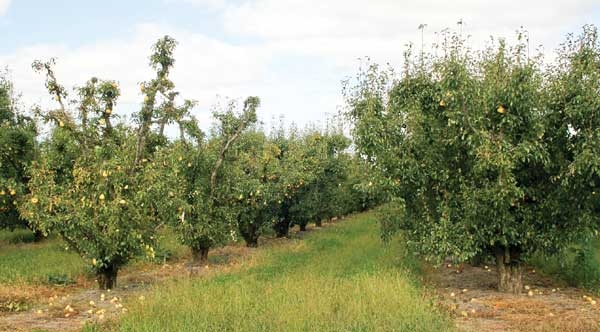Pear decline was originally described as a virus-like agent. It was later determined to be a mycoplasma-like organism that has recently been renamed as a phytoplasma.
In the USA the association between the disease and pear psylla, a small cicade-like insect, became evident as the disease spread down the West coast.
Rootstocks were shown to affect the severity of the disease. Pear trees propagated on Asian rootstock (Pyrus serotina and Pyrus ussuriensis) were most sensitive, whereas trees on French-type rootstock (Pyrus communis) were generally less affected.
In the USA, Winter Nelis and Williams were the most susceptible scion varieties, whereas Comice was somewhat tolerant.
Pear decline symptoms are influenced by tree vigour, environmental conditions, scion and rootstock susceptibility. Generally, trees react to infection by quick decline or collapse of the tree, slow decline, or leaf curl.
Pear decline in Australia
The first serious investigation in pear decline in Australia was carried out in 1995 by two scientists at the Faculty of Science, Northern Territory University, Darwin.
They concluded that the disease ‘pear decline’ was associated with genetically different phytoplasmas. The symptoms of the disease were not identical to published descriptions of pear decline and also, most of the declining pear trees in Victoria were between 40 and 60 years old.
One factor that may have accounted for these differences was the susceptibility of the rootstock or the scion. The origin of the rootstocks was mostly unknown.
Pear trees 40 to 60 years and older, were grown on Keiffer or French Seedling. The latter came from seed from almost any source, including the perry presses in France.
The observations made by the scientists correspond to the time when Pyrus calleryana D6 was introduced—a rootstock that is reported to be resistant to pear decline.
Problem in the Goulburn Valley
Another investigation began in 1997 by the then Victorian Department of Agriculture at Tatura. They undertook a pear health survey to estimate the extent of the pear decline problem in the Goulburn Valley.
The problem seemed to be particularly severe in old Packham’s Triumph trees, although it was also observed in old Williams trees.
The research study, which included investigating the presence of bacteria, wood and soil inhibiting fungi, nematodes, phytoplasmas and viruses, tree nutrition, soil pH and salinity, and water management—especially waterlogging—was never completed and abandoned sometime after 1998.
What appears to be pear decline in old Australian pear orchards can most likely be classified as ‘slow decline’ and is characterised by poor vigour, limbs dying, small pears, and premature ripening of fruit.
Diseased trees, mainly Packhams, are in small or large groups, which appear to be slowly getting bigger. What spreads the disease is unknown.
Eventually, economics dictate the removal the ‘dinosaur’ pear trees, and hopefully pear decline is no longer a worry for pear growers in Australia.
For more information and images, see the November 2011 issue of Tree Fruit




















